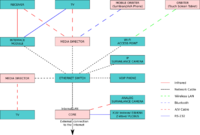Difference between revisions of "Core"
Wierdbeard65 (Talk | contribs) m |
|||
| Line 1: | Line 1: | ||
| − | {{ | + | {{versioninfo|710Status=Relevant info|710UpdatedDate=2nd June 2011|710UpdatedBy=purps|810Status=Relevant info|810UpdatedDate=2nd June 2011|810UpdatedBy=purps}} |
[[Category: Cores| ]] | [[Category: Cores| ]] | ||
| Line 38: | Line 38: | ||
===A Dedicated Core=== | ===A Dedicated Core=== | ||
[[Image:Diagram1.jpg|200px|right]] | [[Image:Diagram1.jpg|200px|right]] | ||
| − | The Core is the central point of the | + | The Core is the central point of the LinuxMCE system and runs applications and daemons needed for the other devices to exchange messages. A dedicated core will run only backend applications and will not provide any frontend, except the web interface. This means it won't act as a media center. You'll need to use Media Directors to be able to play movies, listen to music and watch TV. This kind of setup is recommended when you have plenty of extra devices; this way the backend applications will have full access to the Core's resources. |
| + | |||
| + | This was easy to achieve in 0710 as there was a very handy dialogue box that allows you to switch between core and hybrid. It is however possible in 0810 by disabling AutoStartMedia in "/etc/pluto.conf". | ||
Revision as of 16:18, 2 June 2011
| Version | Status | Date Updated | Updated By |
|---|---|---|---|
| 710 | Relevant info | 2nd June 2011 | purps |
| 810 | Relevant info | 2nd June 2011 | purps |
| 1004 | Unknown | N/A | N/A |
| 1204 | Unknown | N/A | N/A |
| 1404 | Unknown | N/A | N/A |
| Usage Information | |||
Core is the term given to the main LinuxMCE server in your home automation/multimedia network.
All settings for the network are stored in the Core Server. Even if a device is connected to a Media Director PC in another part of the house, it is detected by the Core server and information about that device (its location, functions, and options) is stored on the Core.
In this way, plug-and-play function is provided throughout the LinuxMCE system for all AV devices connected anywhere within the system.
The Core Server provides a standardized LinuxMCE Admin Website to every Media Director, which can be viewed through a browser on any Media Director. The entire system can therefore be administered from any Media Director.
This allows the Core Server to be "headless" (i.e. without a monitor, keyboard, mouse, or any other input or output device), if desired. It is a true server.
The Core PC is also able to provide standardised netboot services to the Media Directors on the home network. In this way, the Media Director PCs do not require their own OS and can act essentially as thin clients. System administration and updates are therefore much easier, as only the Core software needs to be upgraded.
Hardware requirements
Because the Core handles processing for the whole network, it should be the "brawniest" PC in regards to processing power. A dual-core 64 bit processor with a lot of RAM is very nice to have in the Core Server.
Since a Core can be hidden in a closet (or in the garage or basement somewhere) and therefore does not need to be in your living room (unless it is functioning as a hybrid), fan noise is usually not an issue.
The Core PC does require a large amount of storage. This can be large capacity internal hard drives, a large capacity external hard drive, or even perhaps a NAS (network-attached storage) device, that is accessible by being connected somewhere on the home automation/multimedia network.
Of course you need a DVD/CD drive (at least for software installation -- grin)!
The Core should have 2 NICs (network interface cards) -- one for connecting to an "external" network (such as your cable modem, DSL modem, or home LAN router) and one for connecting to the "internal" home automation/multimedia network (your LinuxMCE system network).
Further, it is best to have the TV card in the Core server, as well as the video capture board for any surveillance cameras. A home automation interface is usually attached to the Core as well. Therefore, a PC to be used as a Core must have plenty of expansion slots, and cooling fans proportionate to the load.
Output and sound cards are relatively unimportant for the Core, because output is usually channeled through the Media Director PCs.
Nevertheless, some home automation/multimedia systems channel output through a central whole-house multi-channel amplifier which is connected directly to the Core. If you plan to do this, make the Core into a hybrid, instead, and fit a good (nVidia) graphics card and a good sound card (with surround sound jacks -- 5.1, 7.1, or even 11.1).
Example PCs used as Core servers
See the Core Category for examples of PCs used as Core Servers.
A Dedicated Core
The Core is the central point of the LinuxMCE system and runs applications and daemons needed for the other devices to exchange messages. A dedicated core will run only backend applications and will not provide any frontend, except the web interface. This means it won't act as a media center. You'll need to use Media Directors to be able to play movies, listen to music and watch TV. This kind of setup is recommended when you have plenty of extra devices; this way the backend applications will have full access to the Core's resources.
This was easy to achieve in 0710 as there was a very handy dialogue box that allows you to switch between core and hybrid. It is however possible in 0810 by disabling AutoStartMedia in "/etc/pluto.conf".
